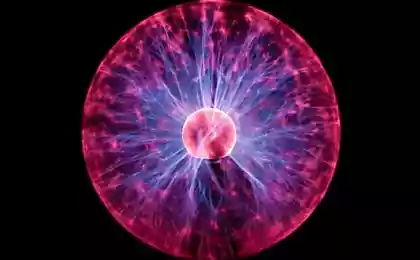225
Mostly harmless: What aliens need to know about Earth

© Kahn & Selesnick
Since the middle of the XX century, mankind has made several attempts to get acquainted with alien civilizations. We have sent radio messages and records into space aboard spacecraft, and today some of them have already left the solar system. The most interesting thing about them is the logic by which their contents were selected: perhaps it will say much more about humanity than all the photographs, records and drawings put together. T&P recalls the Arecibo signal, the Voyager gold disk, and other space letters.
The first attempt: "Peace", "Lenin", "USSR"

The first ever radio message of earthlings to extraterrestrial civilizations was sent in November 1962 from the Evpatoria center of distant space communication. It read, "Peace Lenin. USSR." Scientists used a powerful transmitter that operated at a wave of 39 cm; the recipient of the signal was the planet Venus, which reflected it, which allowed to test the performance of the radar. In 1966, from the center of Evpatoria through Venus, together with specialists from the UK, Soviet scientists sent another message: “USSR”. England. Friendship.
Today, humanity’s short (and probably unreadable) first interstellar writing is moving in the direction of the orange giant HD 131336 in the constellation Libra. The distance to this star is 2 million 158 thousand light years. At the moment, the radio signal has traveled 52 light years. It is noteworthy that it is in the constellation Libra that the star Gliese 581 is located, around which three habitable exoplanets rotate. The most interesting of them - opened in 2007 Gliese 581 s: here the acceleration of free fall is 1.6 g, and the surface temperature varies between +3 and +400C.
Large Radio Letter: The Arecibo Message

On November 16, 1974, scientists from the Arecibo Observatory in Puerto Rico in honor of the discovery of a powerful radio telescope sent the first large and truly informative radio message to extraterrestrial civilizations. It was developed by Frank Drake - the author of the famous equation that allows in theory to count the number of advanced civilizations in the galaxy - and Carl Sagan - American pioneer in the field of exobiology, an astronomer whose activities gave rise to the development of the project to search for extraterrestrial intelligence SETI.
The Arecibo message lasted 169 seconds and was transmitted on a wave of 12.5 cm. In the finished form, it had the shape of a rectangle, and with the right arrangement, the density of numbers was constant, and with the wrong one – not. The letter reflected numbers from one to 10 in the binary system, atomic numbers (the number of protons in the atomic nucleus) of hydrogen, carbon, nitrogen, oxygen and phosphorus, molecular formulas of nucleotide components in human DNA, the number of nucleotide pairs in the genome and the shape of the DNA molecule, brief information about man and humanity, information about the solar system, the radio telescope and the size of its transmitting antenna.
Even if there are contactees on the other end of the line, the delivery of the Arecibo message will take about 25,000 years, and the same amount of time to respond. This letter has been criticized many times: from doubts that its rectangular shape can in principle be deciphered if you are not from Earth (where rectangles are much more common than, say, the shape of cells, familiar to insects), to the fact that the recipient must be able to perceive information optically. It has also been suggested that too many mathematical tricks are required to decipher.
In 2001, a “response” to the Arecibo message appeared near a radio telescope in Chilbolton, Hampshire, United Kingdom: a similar message left on a field with the help of crumpled ears. Instead of a human figure, it depicted a humanoid figure with a large head – the so-called “gray” with large eyes and a small jaw, familiar to us from science fiction films. Then the “answer” made a lot of noise, but the authors of the SETI project said that it is a fake, because, firstly, it is unclear why an advanced extraterrestrial civilization did not use radio waves, choosing a short-lived “grain graphics”, and, secondly, the DNA of the authors of the “Chilbolton message” too much resembled human, although the declared at the beginning of the message silicon did not appear in the list of nucleotides.
Naked nature: records of "Pioneer"

Carl Sagan became the author of another message to extraterrestrial civilizations – graphics on plates of anodized aluminum, launched into space on board the Pioneer 10 and Pioneer 11 in 1972 and 1973. It shows a naked man and woman against the background of a plate-bearing spacecraft (on the same scale), a map of the pulsars of the Milky Way, which shows the distance from them and from the center of the galaxy to the Sun, two basic states of the hydrogen atom and a diagram of the solar system with a mark from where the Pioneer came out. The width of each plate is 22.9 cm, height - 15.2 cm, thickness - 1.27 mm.
Sagan's work has been repeatedly criticized both for its over-anthropocentricity and for "putting obscenity into space." The arrow that marks the direction of the ship’s movement can only be understood by a civilization whose techniques for obtaining food have developed similarly to those of the earth (i.e., hunting with spears or arrows). And a man’s hand that is warmly raised seems to make sense only to us.
Today, Pioneer 10, according to experts, should have already entered interstellar space. The last, very weak signal was received in January 2003, after which the radio transmitter on the ship finally failed. Now this device is moving in the direction of the brightest star of the constellation Taurus - Aldebaran - and can reach it in 2 million years. Pioneer 11 is moving towards the constellation Shield. In neither constellation have we been able to detect exoplanets yet.
Music and map of pulsars: gold records of Voyager

In 1977, another message was sent into space, recorded on the carrier - two gilded plates in cases of anodized aluminum, fixed on board Voyager 1 and Voyager 2. Their diameter is 30 cm, and the precious coating should protect the tracks from the erosive effects of space dust. Together with plastics, each case is packed with a needle for recording and a phonographic capsule. On the box with the plate there are explanations: an engraved scheme for installing the needle and converting the video signal into an image, data on the speed of sound reproduction, another map of pulsars, which notes the position of the Sun in the Milky Way, and a diagram of the emission of hydrogen units to obtain metric units and units of time.
The Voyager Records Commission was again headed by Carl Sagan. This time, the team decided to give most of the music. Classical Western and Eastern works, light and folk music occupy 78% of the space on records. The honor of presenting the West fell to Bach (Brandenburg Concerto No. 2, "Gavot in the form of Rondo", "The Well-Tempered Clavier"), Beethoven (5th Symphony, String Quartet No. 13), Mozart ("The Magic Flute"), Stravinsky ("Sacred Spring"), Chuck Berry ("Johnny B. Goode"), Louis Armstrong ("My Melancholy Blues") and Blind Willie Johnson ("Dark Was the Night"). However, most of the space went to classical music of India, Java and Japan, folk music of Peru, Bulgaria, Azerbaijan, Australia and Africa. The record also features a Chinese work for qisianqin, composed by Bo Ya 2.5 thousand years ago, Georgian choral singing, sounds fluttered from the Solomon Islands and ritual singing of the peoples of New Guinea, which resembles the singing of Stone Age people.
22% of the space on the records is occupied by recordings of human voices and sounds of the planet, as well as 116 images encoded in a video signal. There are greetings in 55 of the most common languages of the Earth, including ancient ones: Sumerian, Akkadian, Hittite, Aramaic, Ancient Greek and Latin. Voyager has the sounds of the ocean and land, the voices of animals and birds, the noise of human activity: footsteps, the sound of a hammer and an axe, the grinding of saws, the howling of jet engines and the roar of a rocket launch, the cry of a child who is calmed by his mother, as well as the rhythmic click of a pulsar, which gives the key to solving the cosmic map on the box.
Also on the plates recorded photos of the solar spectrum, encoded as three monochrome images. Knowing the spectrum of the Sun, you can combine them into a color picture. This makes it possible to see other images in color: a view of the Earth from space and from a low orbit, diagrams of the structure of atoms for acquaintance with atmospheric gases and the DNA molecule and a series of anatomical drawings showing how a cell divides, fertilization occurs, the development of an embryo and the development of an earthly being. There are eight diagrams that illustrate human anatomy. In addition, on the carriers from Voyager, there are photos of landscapes, life forms and human beings: farmers from Guatemala and Australia, workers from Africa, Thailand and the United States, ballet dancers, Olympic runners and others.
Also on the gold plates are recorded the appeals of UN Secretary General Kurt Waldheim and US President Jimmy Carter. Penetrating, but incomprehensible without knowledge of English speech Carter in free translation sounds like this:
This device was created in the United States, in a country with a population of 240 million people among the 4 billion population of the Earth. Humanity is still divided into separate nations and states, but countries are rapidly moving towards a single earthly civilization.
We're sending this message into space. It is likely to survive for a billion years of our future, when our civilization changes and completely changes the face of the Earth. If any civilization intercepts Voyager and can understand the meaning of this disk, here is our message:
It is a gift from a small distant world: our sounds, science, images, music, thoughts and feelings. We are trying to survive in our time so we can live in yours. We hope that the day will come when the problems we face today will be solved and we will join the galactic civilization. These records represent our hope, determination and goodwill in this vast and awe-inspiring universe.”
To date, Voyager 1 has moved away from our planet at a distance of 130,000 astronomical units (1 AU is the average distance from the Earth to the Sun), or 17 light hours and 36 light minutes. It is moving towards the constellation Giraffe and in 40 thousand years will fly 1.6 light-year from the red dwarf AC+79 3888, which is located near the North Star. Voyager 2 will be at a distance of 1.7 light years from the star Ross 248, and after 296 thousand years will approach Sirius.
Source: theoryandpractice.ru























